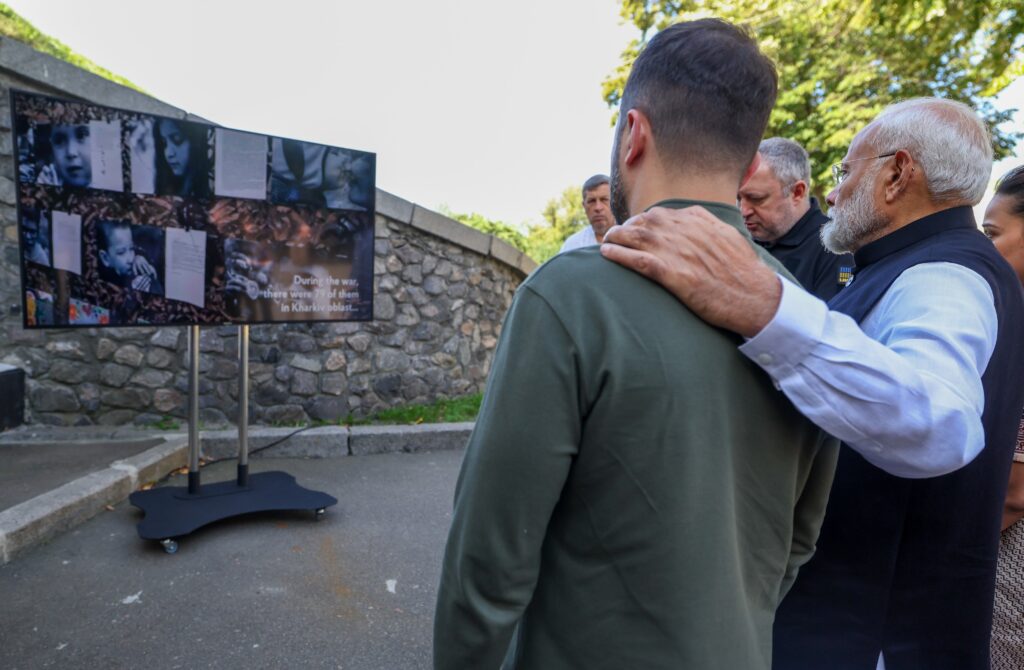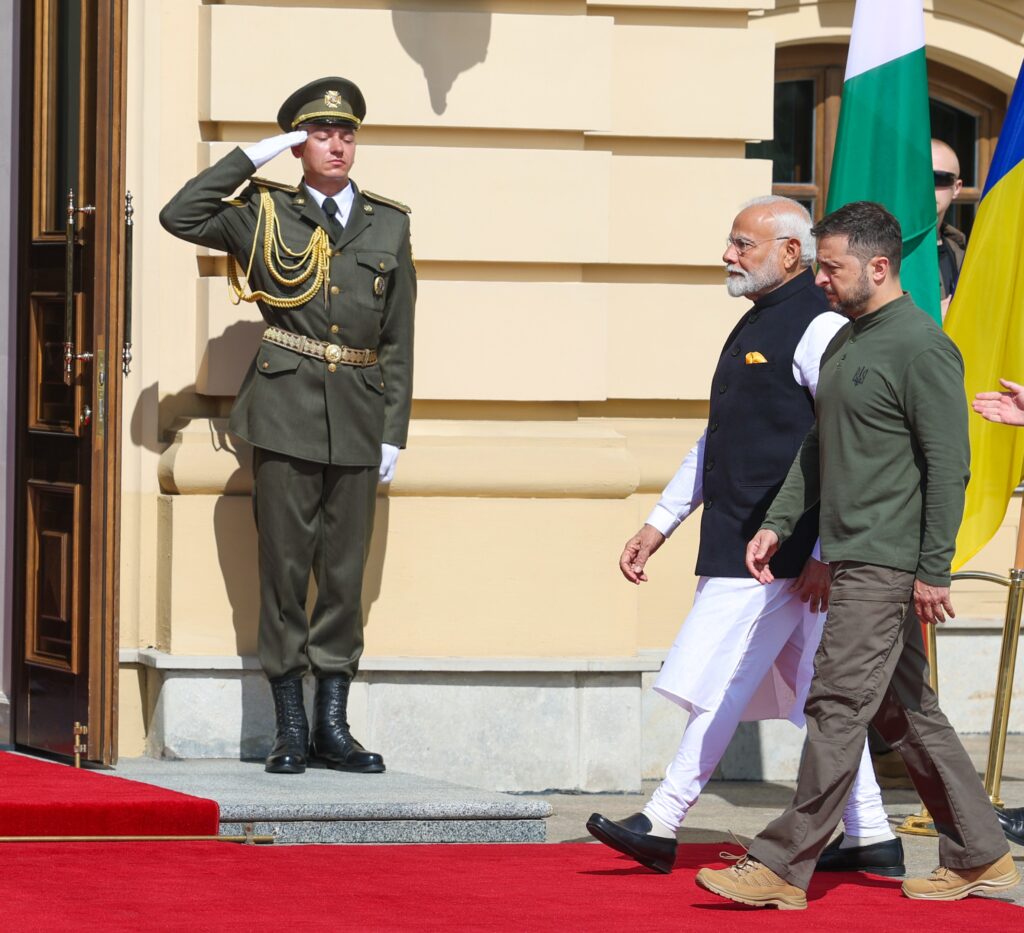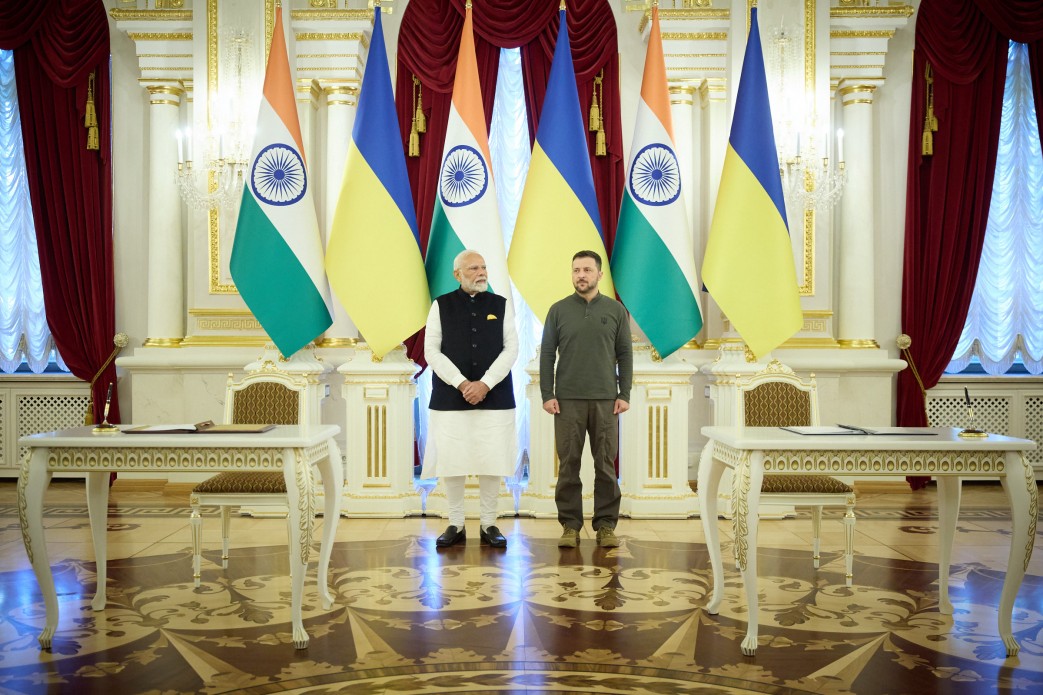Indian Prime Minister Narendra Modi arrived in Kyiv on Ukraine's National Flag Day, on the eve of Independence Day. Ukraine has been independent for 33 years, yet no Indian leader had visited until now.
In contrast, Modi was in Moscow this July - hugging Putin on the same day Russian missiles killed dozens in Ukraine, including at a major children's hospital.
Now, as Modi stood in Kyiv, the context had shifted dramatically: Putin faced humiliation from Ukraine's Kursk offensive.
Speculation swirled around Modi's role as a potential peace broker. A day before arriving in Kyiv, he had reiterated in Warsaw, "No solution can be found on the battlefield" – echoing his statement in Moscow and fueling rumors of a possible message from Putin.
Bloomberg News added to the intrigue, reporting that Modi had "agreed to relay messages between Putin and Ukraine's Volodymyr Zelenskyy, although won't play the role of a formal mediator."
In Kyiv, Modi indeed spoke of peace, urging negotiations between Ukraine and Russia. However, he stopped short of offering specific public proposals.
Yet peace wasn't Modi's sole agenda. India's economic interests, particularly in Ukrainian weapons production, loomed large. With aims to reduce its 86% dependence on Russian arms and bolster defenses against China, India eyed Ukraine's rapidly expanding military industry. Yet, no formal arms agreements were signed.
Modi also wants to avoid tensions with the US, which strongly disapproved of his July visit to Russia. US Ambassador Garcetti warned India not to take US relations "for granted".
Euromaidan Press investigates the real impact of Modi's time in Ukraine.
Modi's peace push: bridging a message from Putin?
India has avoided direct criticism of Russia over the war:
- Avoided direct condemnation of Russian aggression against Ukraine.
- Abstained from UN resolutions critical of Russia's actions in Ukraine.
- Declined to join the joint communiqué at Switzerland's Global Peace Summit on Ukraine, where Russia was absent.
- During a Moscow visit hours after a deadly Russian bombing in Ukraine, Modi called children's deaths "painful" without explicitly blaming Russia.
In Kyiv, Modi and Zelensky shared a hug too, mirroring Modi's earlier reception with Putin in Moscow. Modi denied that India had ever been neutral in the war, claiming that "from day one, we stood on the side of peace." He reiterated his belief that problems cannot be solved on the battlefield.
"The only path forward is through dialogue and diplomacy. Both sides must come together to find a way out of this crisis," the Indian leader said.
The Kyiv meeting was extensive, beginning with a one-on-one discussion between Modi and Zelenskyy before expanding to include key officials from both sides. Andriy Yermak, head of the Ukrainian President's Office, noted the unprecedented three-hour duration of the talks.

However, no public statements were made about any "messages” from Putin.
Beyond Modi's private discussions, experts see potential for India to play a peacemaking role in the Russo-Ukrainian war. Olha Vorozhbyt of the Ukrainian Prism Foreign Policy Council suggests that Modi's peace initiatives largely target a domestic audience, drawing parallels to India's mediator role during the Korean War in the 1950s.
"Modi consistently appeals for peace, but the tangible benefits for Ukraine remain uncertain," Vorozhbyt told Euromaidan Press.
Anastasia Piliavsky, Professor at King's College London's India Institute, concurs, noting that Indians aspire to see their country as a global influencer.
“I think this war is a political opportunity for Modi. It shouldn’t be Modi writing a peace deal and convincing Putin and Zelenskyy to hug. But he could negotiate smaller wins, like the return of Ukrainian children - an action that would resonate well in India,” the expert suggests.
In this context, it's perhaps symbolic that in Kyiv, Zelenskyy took Modi to a memorial for the 570 Ukrainian children killed since Russia's 2022 invasion.

Eyeing Ukrainian arms and economic ties
During talks in Moscow, Putin referred to Modi as "my dearest friend" — and with good reason:
Trending Now
- India-Russia trade surged to $65 billion in 2023, quadrupling since 2021.
- Russian crude imports soared from $2.4 billion (2021-22) to $46.5 billion (2023-24), making Russia India's primary oil supplier.
- Historically, 86% of India's military equipment is Russian-made, with 40% of new purchases still from Russia.
However, this picture is nuanced. Experts note that India's trade with Russia pales in comparison to its EU and US commerce, especially in exports. Even the oil trade shows signs of instability.
"Oil purchases have decreased recently," explains Vorozhbyt. "Indians buy only because of discounts. Without them, they won't purchase."
Defense ties are also evolving. India is diversifying its arsenal with Western supplies, reducing reliance on Russia. Moscow's unreliability as a supplier - exemplified by the failed 2024 S-400 air defense system delivery and high accident rates of Su-30MKI fighters - has accelerated this shift.
"Russia is no longer India's primary defense partner. No new orders have been placed with Russia since 2021," Dr. Swasti Rao of the Manohar Parrikar Institute for Defence Studies and Analyses emphasizes.
This shift opens opportunities for Ukraine, particularly in military technology.
"Ukraine produces gas turbines for Indian naval ships. They can either buy from us or invite production transfer under Modi's 'Make in India' initiative," Olha Vorozhbyt notes.
However, Modi's Kyiv visit yielded four key agreements, notably avoiding public arms deals. The deals focused on softer areas: cultural cooperation (2024-2028), agriculture and food industry collaboration, and medical field partnerships.

Modi's reputation repair
Reputation management emerges as another significant aim of Modi's Ukraine visit. After all, his trip to Moscow and embrace with Putin didn't appear neutral at all, says Olga Vorozhbyt. This visit was perceived negatively in Ukraine and the West. However, India seeks to maintain close US ties, given shared interests in containing China.
"China's aggressive policies in Sri Lanka, its growing presence in the Maldives, and territorial disputes with India in the Himalayas are concerning," Vorozhbyt explains. "Add to this China's activities in the South China Sea, and it's evident why India is uneasy."

Shashi Tharoor, a former UN under-secretary-general and Indian Minister of State for External Affairs, suggests that India could leverage its long-standing relationship with Russia to help defuse the Ukraine war, a move the US would welcome.
“The India-Russia joint statement in July welcomed peace proposals ‘in accordance with international law and on the basis of the UN Charter.’ Modi could conceivably use his upcoming trip to Ukraine to explore the feasibility of this option,” the politician says.
Success would bolster India's global standing, while failure could damage its diplomatic credibility. As Modi navigates this challenge, his ability to satisfy competing interests while presenting a unified diplomatic front will be crucial in shaping India's role on the world stage.
Read more:
- Modi's Kyiv trip: Desperate attempt to salvage India's reputation
- Indian PM Modi to offer mediation in Russia-Ukraine war during Kyiv trip
- Indian PM Modi to visit Ukraine
- Eight Indians killed while fighting against Ukraine in Russian army

